The Official F-19 Stealth Fighter Handbook
by Richard Sheffield
OPERATION: Battering Ram
The dim glow from the emergency lights refused to creep into the dark corners of the hardened aircraft hangar. An F-19 Stealth Fighter sat quietly under the cool red light in the center of the bay. Captain John "the Judge" Marshall sat sullenly in the far corner, leaning back against the wall in a metal folding chair. A close friend was dead. This was a side of combat he had not experienced before and he didn't like it, not one bit.
Marshall, and his squadron of Stealth Fighters named Team One—Furtim Vigilans (Covert Vigilantes), had been mobilized to Lakselv Airbase on the cold northern Norwegian coast two days ago, due to the increasing tensions between the USSR and Norway. After repeated warnings to the Soviets about incursions into their territorial waters, the Norwegian Navy isolated and then sank an intruding Soviet Victor III class nuclear powered attack sub. A trailing Soviet Alpha class sub responded by torpedoing three Norwegian ASW ships. Loss of life was heavy on both sides. The following day there were a number of border clashes. Most were minor firefights, but there were at least two locations where overeager Soviet officers had crossed the border and were now occupying Norwegian soil.
Fearing a massive NATO retaliation, the Soviets decided to make a preemptive strike against Norwegian airbases close to the border. Behind extreme radar jamming, a squadron of TU-95 Bear bombers managed to get close enough to launch a wave of AS-15 conventional cruise missiles. At Lakselv Airbase the F-15s scrambled in time to down three of the six incoming missiles, but three got through. Damage was light compared to other bases closer to the border, but one of the missiles scored a direct hit on an aircraft hangar. These concrete and steel hangars were designed to be tough but not to stand up to a direct hit from an AS-15. The resulting fire and explosion claimed sixteen lives, including an F-19 pilot and his crew chief.
That pilot was Marshall's closest friend. He had been his wingman when they flew F-llls together out of England. Together they had seen it all, from barfights in the back-alley dives of Subic Bay to the tapestry covered walls of Saudi Arabian palaces. They had flown side by side during the Tripoli raid in 1986, and now he was gone. All Marshall could think about was revenge against the Soviet air force. At dawn, he would get his opportunity.
Marshall stared right through the white cloud that hung in front of his face as his breath hit the cold air in the hangar. He didn't feel the chill as he imagined the targets for the coming operation. At dawn, 24 F-19s from four different airfields would stream across the border seeking targets on the Soviet Kola Peninsula. The Russians had been anticipating a nighttime attack and seemed to relax when the low arctic sun finally appeared. It would cost them. Marshall had helped plan the raid and thus assigned to himself the targets he wanted. His beef was with the Soviet air force—it was payback time. The same squadron of TU-95s that had launched the attack against the airbases had been refitted with nuclear cruise missiles and was now orbiting menacingly behind the lines. It was an obvious warning for NATO to keep its distance.
But NATO Command in Brussels had planned a warning of its own, and Marshall and the F-19s were at the point of the spear. If all went according to plan, they would first take out the Bears and then select ground based targets, including radar sites as well as the circling IL-76 Mainstay AWACS aircraft. If successful, Operation Battering Ram would leave the door to the Kola Peninsula wide open for an air attack—an attack that wouldn't come if the Soviets could be forced to the bargaining table before this thing got too far out of hand.
One of the Bear bombers was circling over Kildenstroy, just south of Murmansk. Marshall visualized his Primary Target and played through the scenario again in his mind. For the twentieth time he saw the bright trail left by his missile and the moment of impact.
"Yo, Cap'n!" shouted the Crew Chief Bubba Spencer, who slammed the hangar door and jolted Marshall out of his reverie.
"Back here," answered the captain quietly, as the echoes of the sergeant's entrance faded away.
"The sun's about to peek over the hills, sir, time to saddle up and ride."
Marshall stood and strode slowly toward the aircraft. He passed the sergeant without saying a word, climbed up the metal ladder, and slipped into the cockpit. Bubba followed him up to help him strap in.
"Boss, you don't look so good. You ready for this one?"
"Bubba, this cockpit is my office. And when I'm in the office, I take care of business. Don't worry, I'll even the score today. Let's crank 'er up."
Just before a latecoming dawn at 0930, eight F-19s taxied from their hangers in unison and rolled towards the flight line. Without any radio chatter, each pilot took his place in line as they turned onto the runway. Marshall watched the parade with pride; these men were professionals, out to do a job. He rolled up next to another F-19 for the scheduled tandem takeoff. The two aircraft in front of him rolled together down the runway, the roar of the engines only a distant hum through his canopy and helmet. When they left the ground and rolled to the right, Marshall and the other fighter started their takeoff roll. Without a word or a glance, the two aircraft stayed together as they flashed down the darkened runway, nosing up to leave the ground at the exact same moment. They leveled off at 500 feet and flew together for a few minutes. Then at ten kilometers from the base, Marshall looked over and gave a big thumbs up to his partner only 30 feet away. With that, he rolled to the left and the other plane rolled to the right, each now taking a lonely course to his distant target.
Marshall turned and pointed his plane due north, heading for the Norwegian Sea. Since his target was fairly close to the shore, he had chosen to use the amazing fuel efficiency of the F-19 to fly out over the water and parallel the coast, just out of radar detection range. The occasional chirps in his headphones from the radar detection gear were the only sounds he heard as the F-19 weaved in between the hills. Already he was picking up signals from the big SA-12 site at Nikel, just across the border. Avoiding that site would take him way out over the Barents Sea, straining his limited fuel supply even with the extra tank he carried in one of his bays. The other bays were loaded with a full bag of Sidewinders, AMRAAMs, and MK 35 IN Incendiary Cluster Bombs. He planned on returning with all bays empty.
He crossed the rocky shore and turned slightly to the east. The signal from Nikel was coming in strong, so he backed off the throttle and settled down to 200 feet to reduce his radar signature. Checking the Tactical Display set on maximum range, Marshall noted that the aircraft carrier USS Kennedy and its protective group had moved into position north of Norway. "This is getting serious." The display showed a group of Navy F-18 Hornets flying CAP over the carrier.
When the signal from the SA-12 radar at Nikel finally started to fade, Marshall banked to the right and took a course parallel to the coastline, still bouncing along at low level. Two patrolling MiGs appeared on the display to the south, probably circling over Pechanga. As long as he stayed to the north they would pose no problem. Other aircraft occasionally popped up near the border—must be light attack aircraft in support of the ground troops. At this range he had no way of telling which side they were on. Gloved fingers clicked on the keyboard as Marshall activated the TrackCam in air-to-ground mode. The first thing to show up on the small CRT was a Soviet Krivak-class destroyer steaming west, just north of the huge port at Murmansk. It was not broadcasting radar, but he would have to keep an eye on it. Some of the newer ones carried a very effective doppler system.
Marshall worked his head from side to side. Though he had yet to encounter the enemy, the long distance low-level flight had placed a great deal of stress on the pilot. A computer generated message flashed up on the HUD, WAYPOINT 2 REACHED. He was due north of Murmansk and eased the stick to the right to start a gentle turn inland.
Marshall relished this mission. He had managed to arrange it so both of his assigned targets were part of the Soviet air force. He had lost track of the big picture. He just wanted retribution. His right hand caressed the stick as he bounced in the turbulence at 150 feet. The cool white lights on his HUD showed Heading 170, Speed 203, Altitude 155. Maybe he was crazy to be doing this, but he was also extremely good at it.
He approached the Soviet coastline about halfway between the port cities Murmansk and Severomorsk, dipping closer to the deck to avoid a small SA-2 battery. The white sands of the shoreline blazed in the early morning sun as Marshall went “feet dry” over the craggy landscape. Taking a deep breath, he tried not to think too much about the seriousness of flying a combat mission against the Soviet Union. He switched the HUD to air-to-air mode and began to scan for his target. Marshall's racing heart beat even faster when three aircraft appeared on the Tactical Display circling over Kildenstroy. “Okay, let's sort out who's who.” He adjusted the TrackCam to lock onto the closest target. A perfect picture of a lazily turning MiG-31 snapped onto the CRT. A quick keystroke switched the camera to the next target, which turned out to be a SU-27. “Just a couple of high-priced baby sitters.” Marshall switched the camera again and the huge TU-95 Bear bomber flashed onto the screen under the words PRIMARY TARGET.
Marshall's fist tightened around the stick, as he fought the urge to go to full power and rush the attack. A quick scan of the instruments showed all systems to be nominal as he selected an AMRAMM missile. A quick red flash on the EMV scale caught his attention. He had been hit by a very strong radar signal—not strong enough to detect him yet, but enough to worry about. A new symbol appeared on the Tactical Display and he requested further information on the radar site from the computer. OVER THE HORIZON DOPPLER RADAR SYSTEM—LOCATION KIROVSK, was the reply. The next pulse from this site was even stronger, three-quarters of the way down the scale, and Marshall was heading right towards it.
Marshall gritted his teeth. “This puts a whole new twist on things.” Between pulses, he banked the aircraft hard and pulled out on a course heading of 200. He could maintain that course and not get any closer to Kirovsk and still close on the target over Kildenstroy. The range to the Bear was closing fast. Just 40 km and he still had not been spotted. It didn't stand a chance.
At 36 kilometers, the words TARGET LOCKED appeared on the CRT. Marshall moved in for the kill. Slowing to a mere 140 knots, he managed to avoid the strong radar searches of the circling fighters.
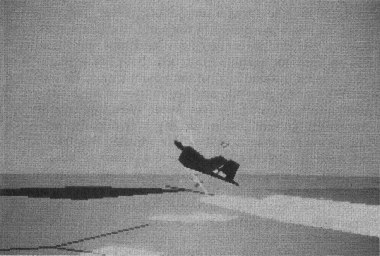
Like a big cat stalking its prey, Marshall moved slowly, hugging the ground until just the right moment. When the range closed to 20 km, he pounced with lightning quickness and ferocious force. Pushing the throttle to the stops, he quickly gathered the speed he would need to engage the Bear and its escorts. When the range closed to 16 km, the Targeting circle turned bright red and Marshall reefed back on the stick to bring the higher-flying Bear into the middle of the missile envelope. The bay doors whined open and he squeezed the trigger unleashing an AMRAAM. Marshall felt the aircraft shudder as the aircraft hunting missile flared off the rail. Now at high speed and clear of the ground clutter, the F-19 was just another fighter, very vulnerable to radar detection. The flash of the air-to-air missile was seen by the bomber pilot, who started a diving turn down into the clouds to try and escape. The two fighters turned towards the F-19, but Marshall locked them up and put them on the defensive with a missile aimed at each.
Marshall looked back over his shoulder and followed the white trail left by the first missile. The lumbering Bear twisted and turned but could not shake the agile missile. Thirty feet away from the Bear's undercarriage, the proximity fuse detonated and ripped the belly of the aircraft open. The bomber started to tumble and then exploded with a flash, disappearing into the clouds. Gone so quickly.
The two fighters were still turning hard to avoid the incoming missiles. Marshall kept them on the defensive with a closer-range Sidewinder shot at each and then dove for the deck and safety. He cut the throttle and tried his best to disappear, screeching over a wheat field at less than 100 feet. He felt a deep satisfaction when a message came up on the HUD telling him both of the fighters had gone down in flames.
Three-hundred kilometers away back over Norway, the operators in the E-3A Sentry AWACS plane also felt satisfaction as one by one, the Bear bombers blinked off the radar screens. The oddly shaped Stealth Fighters had once again proved their worth and eliminated the cruise missile threat. But there was still more to do.
Marshall knew he would have to act quickly now if he was going to complete his secondary mission. The elite MiG-31 fighter wing at nearby Kilpyaur would be scrambling due to his attack on the bomber, and Marshall wanted to catch them on the ground. He switched to air-to-ground mode and scanned until he found the airfield and the nearby SA-5 SAM site; the SAM would be a problem. Only 30 kilometers away, the site was close to picking him up, but not quite yet. He headed straight for it, keeping low. Radar energy from the old pulse system hit him again, but not enough reflected back for the operators to detect him.
At ten miles out he turned hard back towards the airfield. BONK! The next pulse flashed all the way down the scale and got him. One more and they would have a good track. But it was too late. The airfield was only five kilometers away. Marshall armed and readied the Mk 35 Cluster Bomb Units and lined up the runway for his approach. At 3 klicks out he popped up to 500 feet, punched open the bay doors, and then hit the pickle button to drop a CBU as the busy airfield flashed underneath him. Numerous taxiing aircraft and roving fuel and ammo trucks were in plain view. Once it left the F-19's bay, the CBU broke open and spread hundreds of baseballsized incendiary bomblets over several hundred square yards. Whatever they hit was immediately covered with burning liquid. This included the fuel trucks and armed and fueled aircraft waiting to take off.
A fire storm swept across the base. Fuel trucks exploded, sending sheets of burning JP fuel in all directions. Dozens of aircraft were damaged either by the sticky burning liquid or by the resulting explosions. As the fire grew, exploding ordnance that cooked off due to the heat forced the firefighters out of the area. There was nothing they could do but watch it burn. This fighter wing would be out of operation for the duration. “Secondary Target destroyed.”
But the SA-5 SAM site was not caught in the fire and quickly sent a large SA-5 Gammon missile racing after the intruder. Marshall noticed the missile lock right away and turned hard to get the missile broadside to him. At almost mach three the SAM ate up the range quickly. Marshall punched out a decoy drone and let out a deep breath as the SAM passed safely behind him. But he was not out of the woods yet. The decoy would die out in another couple of seconds, giving the SAM crew another shot. So rather than turn away from the site, Marshall headed back towards it with a high-G climbing turn. Marshall let out a low groan as his body weight was suddenly multiplied by five. Just as the decoy gave out, the Track light came on again, but Marshall was doing some tracking of his own. Before the crew could launch another Gammon missile, he streaked over the site and covered it with another load of burning bomblets. The remaining five missiles caught fire and cooked off on their launchers, aiding the destruction of the main guidance radar.
Other F-19s had been equally successful with their targets. The two Soviet 11-72 airborne controllers were both quieted with U.S.-made missiles. But there were still a large number of fighters in the air, and without their airborne controllers, they were desperately looking for something to shoot. The fire at the airbase sent a huge cloud of smoke and fire into the air, which drew fighters to the area like moths to a flame. Suddenly the air around Captain Marshall became very crowded.
With MiGs closing in from the north, south, and west, Marshall took a second to consider his situation. A quick runthrough of his weapons showed only two Sidewinder missiles, but he still had a full magazine of cannon shells. He figured he might have time to sneak back to the north and out over the water but he wanted a shot at the Soviet air force, and what looked like half of it was headed his way. Besides, with their IL-76 aircraft gone, he had an advantage—he could see them and they couldn't see him.
A check in air-to-air mode showed six incoming aircraft. Two MiG-29 Fulcrums from the west, two SU-27 Flankers from the south, and two Yak-38 Forgers from the north. Marshall was surprised to see the Yaks—the Kiev aircraft carrier must be in port. With only two missiles left, he decided to go after the MiG-29s first, though they were only slightly more dangerous than the SU-27s. The lowly Yaks, on the other hand, should not be a problem.
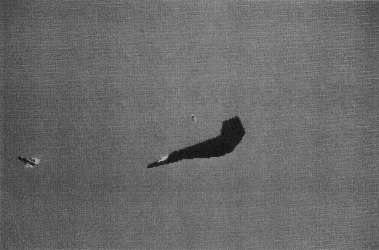
Marshall weaved around so the MiGs would pass by on his right. He stayed down on the deck in the early morning shadows, feeling very exposed operating in the daytime. He had planned to whip around on the tails of the MiGs as they passed for a classic rear quarter shot, but a check of the TrackCam showed they were probably closing too fast. By the time he could swing the F-19 around, they would be moving out of the Sidewinder's effective envelope. Besides, it looked like the two Flankers would cross his path first. The slower Yaks were lagging behind.
"Let's try it this way then." Marshall heaved the fighter over onto its side and turned hard toward the SU-27s. Increasing the throttle, his oxygen mask pressed back into his face as he held the turn to keep his nose ahead of the closest fighter in a good lead-pursuit position. At over 1000 knots closure, the Soviet fighter grew rapidly in his windscreen. He was surprised they hadn't picked him up on radar yet; the next pulse might get him, but he would be past them soon.
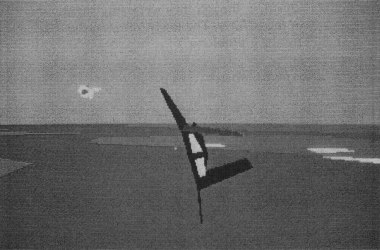
It happened very quickly. As the Flankers sped in from the left, Marshall held his lead on the fighters and then pressed the trigger to send a sheet of explosive shells out in front of them. As they flashed by in front of him, the lead aircraft nosed right through the stream of gunfire and exploded. Marshall grimaced as he flew right through the pall of smoke left in the air, not knowing what debris he might be sucking into his engines. He jammed the throttle forward and slid behind the other flanker. Yanking the aircraft over again, he turned to face the two MiGs that had passed behind him during the gunfight. They were both turning hard to come back and investigate, having seen the Flanker cartwheel into the ground. A bright blue flash on the EMV scale and a warning tone told Marshall that within a couple of seconds all the aircraft would know his position. The two MiGs pulled out of the turn headed straight for the F-19. But the "Judge" was quicker on the draw and sent a Sidewinder racing after each plane.
Meanwhile, the other SU-27 had maneuvered around onto Marshall's tail and announced his presence with an AA-8 Aphid heat-seeking missile. Marshall put the F-19 into a shallow dive to pick up airspeed. The throttle was already all the way forward. Even with the F-19's reduced IR signature, the AA-8 had no trouble locking onto the fighter and quickly made up ground. The airspeed indicator on the HUD was counting up past 450 knots when the Missile Proximity Klaxon sounded. Impact was just seconds away. Marshall punched out two flares, flicked on the IR jammer, and pulled a six-G turn to the right. He grunted and tightened his abdominal muscles to try and keep his blood from pooling in his legs. Even so, the world went to black and white as the blood left his head. The Flashing red 1 indicating missile lock blinked off for a moment, fooled momentarily by the countermeasures. But it quickly reappeared, flashing steadily in the corner of Marshall's right eye. Marshall held his turn, concentrating through his tunnel vision, still fighting against the mounting Gs. Finally the Flashing I went off. The countermeasures had fooled the missile just long enough so it was late following the F-19's turn, forcing it to eventually overshoot.
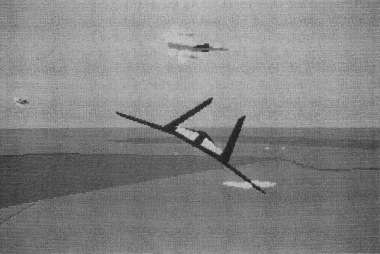
The MiGs were not so fortunate. The new M-generation Sidewinders bore right through the trail of flares left by the fleeing fighters and stayed padlocked onto the hot engines. They exploded only a second apart and sent the two fighters trailing smoke into the ground.
The other flanker was still behind Marshall; it fired off another AA-8, which never locked on. The F-19's hard turn had bled off a lot of airspeed, and the Flanker pilot struggled to slow up and stay behind the oddly shaped fighter. The range had closed to less than a kilometer. Marshall jinked his plane wildly, trying to stay out of the Flanker's gunsights. He jerked quickly to his right and then back hard to the left. The Flanker pilot did not react quickly enough and wound up heading to the right while Marshall was turning left. The Soviet pilot quickly reversed his turn to follow the F-19, but Marshall reversed his turn also, once again catching the Soviet going the wrong way. The Soviet realized his mistake too late. As he turned hard to get back on the F-19's tail, Marshall cut power and extended the speed brake. The Flanker pilot watched helplessly as the F-19 slowed up quickly and slid underneath him. Marshall's perfectly timed scissor maneuver had caused the Flanker to overshoot above him. He used what little airspeed he had to bring the nose of the aircaft up for a quick gun shot at the scrambling Flanker.
"You're a mort!" He only got off one burst before the aircraft stalled and nosed back down. But with the range only a couple hundred yards it was enough. The short-range burst took one of the Flanker's horizontal stabilizers off at the base and raked the belly of the aircraft, causing an immediate hydraulic failure. The Soviet took the wise move and optioned for a silk-assisted landing. Marshall saw the chute bloom open to his right as he successfully battled to pull the Stealth Fighter out of the stall.
The slow Yak-38s were just now arriving. The worried pilots had witnessed the numerous explosions and now could not raise their comrades on the radio. Their pathetic radars did not give them a clue as to the F-19's whereabouts. They flew in slowly and surveyed the damage. The airbase and the SAM radar site were still ablaze, and four smoking craters marked the impact points of the other Soviet fighters. The pilot of the lead Forger hoped that whatever had done all this was gone. His VTOL Yak-38 was not much of a fighter. It was heavy, slow, and had an outdated fire control system, certainly no match for a MiG-29 or anything that could shoot one down.
The pair flew in a relatively loose formation with about a half kilometer separation. They were busily reporting what they had seen back to the ship and not keeping as close a watch on each other's tail as they should have been. Marshall swung around behind a small group of hills at low level and approached one of the slow moving Yaks from the rear. Without letting the Yak wingman give a word of warning, the F-19 pulled up from low level onto the Yak's tail and sprayed it with cannon fire. A frantic radio call for help came too late. Fire warning lights flashed, warning klaxons blared in the Forger's cockpit, and engine output dropped to almost nothing. The pilot just had time to look over his shoulder and watch his wingman turn hard away and dive for speed. He shook his head and reached between his legs for the eject handle.
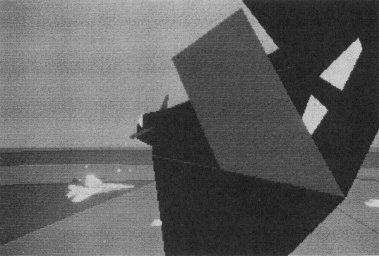
Marshall watched the other Yak beat feet, headed back to the ship. He thought about pursuing the fleeing aircraft, but a quick check of the fuel gauge told him that would not be a good idea. Besides, there were other fighters headed in from the south. It was time to make a graceful exit.
He cut the throttles and headed back down to low altitude. A check of the Map Display showed a lot of radar activity due north, between Murmansk and Pechenga. So he turned to a 035-degree heading, which would take him back through the gap between Murmansk and Severomorsk. He activated the extra fuel tank he was carrying and pumped the contents into the main fuel cell. "Maybe taking on those fighters wasn't such a good idea after all." He ran it through the computer again, but it came out the same way. He might not have enough fuel to get home.
Back out over the water, he headed due north for a while and then back to the west. He pulled up to 500 feet whenever there was no danger of radar in the area. The smoother ride there should help his fuel economy. But the indicator on the fuel gauge seemed to be marching double-time towards the bottom of the scale. He pulled out his briefing notes and looked for a closer airstrip of any sort. But Lakselv was it. Even the highways were covered with snow and ice. Then a germ of an idea started to grow in his head. "Nah, I don't even want to think about that!" But as the minutes clicked off the digital clock and the engines sucked up more fuel, it didn't look like he had a choice. He pulled out his charts and notes, looking for the radio frequency and call sign for the aircraft carrier USS Kennedy.
He didn't get very far with the air boss on the carrier, so he contacted the ever watchful E-3A Sentry AWACS plane and explained his situation. The F-19 did have a hook to catch the arresting cable on the carrier's deck. And he had done carrier landings in practice, although never on an actual carrier. He always figured any mission that required carrier operations would be flown by one of the three former Navy pukes in his squadron. Never in his wildest nightmares did he think he would actually have to land on a carrier some day. But the carrier was 60 kilometers closer than the base and reachable. It was that or ditch a 60 million dollar aircraft and risk freezing to death in the Arctic Ocean.
The AWACS controller came back on the radio and told Marshall he'd convinced the carrier to let him try a landing. He asked if he wanted the carrier to raise the crash barrier to catch him. But the cables in the barrier would total his fragile aircraft just as surely as if he had dropped it in the ocean. No way. He said he would try and catch the cable.
The Kennedy agreed to let the captain try and land. They turned into the wind on a 180-degree heading. Marshall would have to come around and land from the north, straining his limited fuel even further. He adjusted his course to take him 20 kilometers north of the Kennedy. Easing up to 1000 feet, he settled into a smooth flight at 200 knots. Once he was almost due north of the ship, he turned back hard and lined up on a 180-degree heading with the ship dead ahead. He activated the Instrument Landing System and lowered his landing gear. The ILS would give him the proper glidepath to follow to hit the deck. Ten kilometers out he started a gentle descent waiting for the glidepath indicator to catch up with him. The inside of the small fighter suddenly got hot and sticky as he fought to keep the tiny carrier deck lined up. When he intercepted the glidepath, he cut his throttle and let the nose down a little to keep the bar in the center of the scale. "Jeez, I'm coming in steep!" A carrier approach was much steeper than normal, and it had been awhile since he had practiced one. The Low Fuel Warning Light on his console started to flash—he would only get one pass at this.
Sweat poured down his face and his heart raced as the deck climbed towards him. The cables became visible and he pointed his nose right at them. "This is really crazy!" He could see the rescue helicopters hovering off to the side of the ship, waiting for him to put it in the drink. The ondeck betting was probably furious.
Three kilometers out and the deck loomed in front of him, he still pointed his nose right at the cables. Two kilometers . . . one . . . there was no turning back now. Just when it looked as if he would plow nose first into the deck, he opened the speed brake and pulled the nose up.
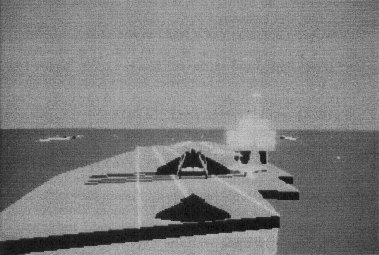
WHAM! The whole aircraft shook as the gear slammed into the deck. Marshall felt like he had been dropped out of a second-story window in a recliner. He jammed the throttles forward, not knowing if he had caught the cable or not. Then suddenly he hit a brick wall; at least that's what it felt like. The hook caught the cable and the aircraft went from 160 knots to 0 in a fraction of a second. Marshall was thrown forward against his straps and momentarily dazed by the sudden stop.
When his eyeballs stopped spinning, there was a smiling face with an odd headset pounding on the canopy next to him. He had done it! He had actually landed on a carrier! Regaining his wits, he opened the canopy and was helped down as the deck crew attached a small tractor to the front wheel of the F-19 to tow it to the hangar elevator. Marshall was greeted by a smiling group of the deck crew. Thumbs up and back slaps all around. The commander of the carrier's air group, with CAG across the front of his blue baseball cap, cut his way through the crowd to Marshall and led him to a hatchway in the island structure. Once in the quieter hallways of the carrier, the CAG gave Marshall a smile and a wink. "Not half bad for an Air Force puke!"
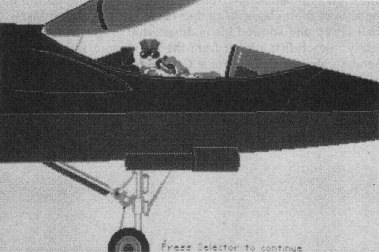
The helicopter ride from the Kennedy back to Lakselv had been long and cold. Marshall was the last pilot to arrive back at the base. By the time he was finished with his debriefing, the party in the Officers' Club was well underway. All of the pilots had made it back safely, and each was carving up the air with his hands as he explained his heroics in great detail.
When Marshall stuck his weary but smiling face through the door, a loud cheer went up over the already noisy party. It was obvious to everyone that Marshall and his crew chief had already started celebrating, as someone had painted eight red stars on the side of his face, one for each Soviet aircraft he had downed. Marshall leaped in the door letting out a hoot and clutching something tightly in both fists. A voice from the end of the bar yelled out, "The Judge is cleared for landing, call the ball," giving him the standard aircraft carrier landing clearance.
Marshall yelled back, "Roger, the Judge has the ball!" And with that he took three long strides, stepped up and off the back of a colonels's chair, and launched himself head-first towards the dripping bar top. He made a perfect carrier landing on his belly and slid the length of the bar with his arms outstretched, scattering bottles and pilots in all directions. The "fire crew" immediately arrived to douse his flames with the contents of their glasses. Another cheer went up when Marshall sat up and showed his buddies what he was clutching so tightly in each fist: a letter from the wing commander recommending him for the Air Force Cross and a new set of major's insignia. It would be quite a party.
Table of Contents
Previous Section: OPERATION: Federal Express
Next Section: Appendix A. Getting the Graphic for the Real Stealth Fighter—the F-117A
